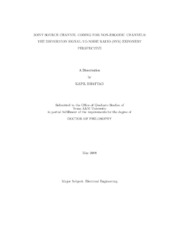| dc.contributor.advisor | Narayanan, Krishna R. | |
| dc.creator | Bhattad, Kapil | |
| dc.date.accessioned | 2008-10-10T20:56:19Z | |
| dc.date.available | 2008-10-10T20:56:19Z | |
| dc.date.created | 2008-05 | |
| dc.date.issued | 2008-10-10 | |
| dc.identifier.uri | https://hdl.handle.net/1969.1/85928 | |
| dc.description.abstract | We study the problem of communicating a discrete time analog source over
a channel such that the resulting distortion is minimized. For ergodic channels,
Shannon showed that separate source and channel coding is optimal. In this work we
study this problem for non-ergodic channels.
Although not much can be said about the general problem of transmitting any
analog sources over any non-ergodic channels with any distortion metric, for many
practical problems like video broadcast and voice transmission, we can gain insights
by studying the transmission of a Gaussian source over a wireless channel with mean
square error as the distortion measure. Motivated by different applications, we consider three different non-ergodic channel models - (1) Additive white Gaussian noise
(AWGN) channel whose signal-to-noise ratio (SNR) is unknown at the transmitter; (2)
Rayleigh fading multiple-input multiple-output MIMO channel whose SNR is known
at the transmitter; and (3) Rayleigh fading MIMO channel whose SNR is unknown
at the transmitter.
The traditional approach to study these problems has been to fix certain SNRs
of interest and study the corresponding achievable distortion regions. However, the
problems formulated this way have not been solved even for simple setups like 2
SNRs for the AWGN channel. We are interested in performance over a wide range
of SNR and hence we use the distortion SNR exponent metric to study this problem.
Distortion SNR exponent is defined as the rate of decay of distortion with SNR in the high SNR limit.
We study several layered transmissions schemes where the source is first compressed in layers and then the layers are transmitted using channel codes that provide
variable error protection. Results show that in several cases such layered transmission
schemes are optimal in terms of the distortion SNR exponent. Specifically, if the band-
width expansion (number of channel uses per source sample) is b, we show that the
optimal distortion SNR exponent for the AWGN channel is b and it is achievable using
a superposition based layered scheme. For the L-block Rayleigh fading M x N MIMO
channel the optimal exponent is characterized for b < (|N - M|+1)= min(M;N) and
b > MNL2. This corresponds to the entire range of b when min(M;N) = 1 and
L = 1. The results also show that the exponents obtained using layered schemes
which are a small subclass of joint source channel coding (JSCC) schemes are, surprisingly, as good as and better in some cases than achievable exponent of all other
JSCC schemes reported so far. | en |
| dc.format.medium | electronic | en |
| dc.language.iso | | |
| dc.publisher | Texas A&M University | |
| dc.subject | information theory | en |
| dc.subject | joint source channel coding | en |
| dc.subject | distortion exponent | en |
| dc.title | Joint source channel coding for non-ergodic channels: the distortion signal-to-noise ratio (SNR) exponent perspective | en |
| dc.type | Book | en |
| dc.type | Thesis | en |
| thesis.degree.department | Electrical & Computer Engineering | en |
| thesis.degree.discipline | Electrical Engineering | en |
| thesis.degree.grantor | Texas A&M University | en |
| thesis.degree.name | Doctor of Philosophy | en |
| thesis.degree.level | Doctoral | en |
| thesis.degree.level | Doctoral | en |
| dc.contributor.committeeMember | Sprintson, Alexander | |
| dc.contributor.committeeMember | Daripa, Prabir | |
| dc.contributor.committeeMember | Pfister, Henry | |
| dc.contributor.committeeMember | Miller, Scott L. | |
| dc.type.genre | Electronic Dissertation | en |
| dc.type.material | text | en |
| dc.format.digitalOrigin | born digital | en |


